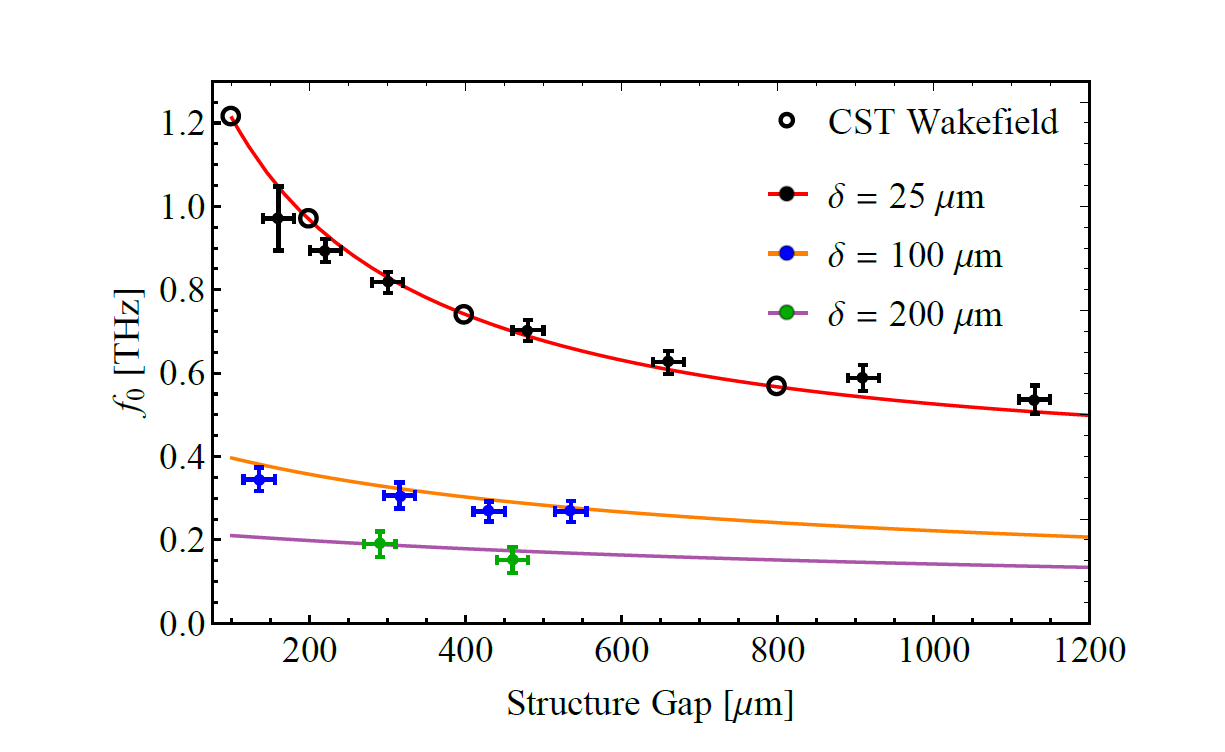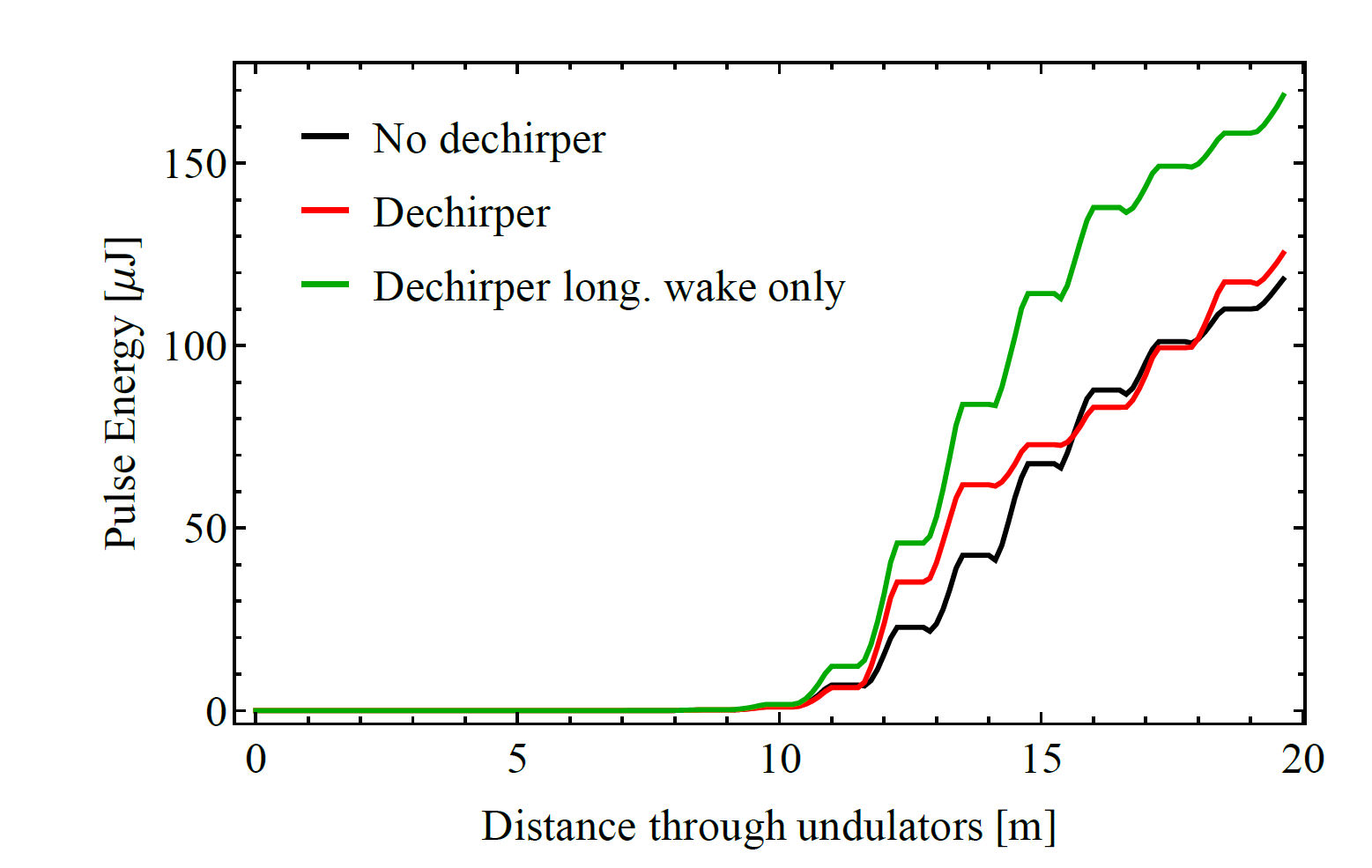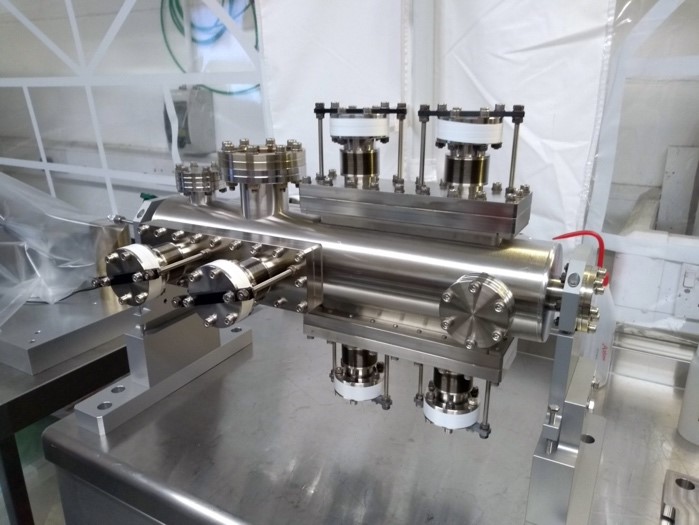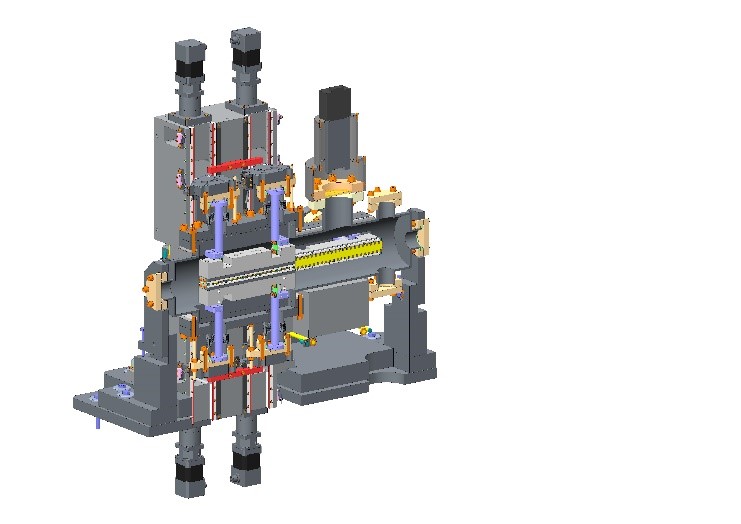Dielectric Wakefield Acceleration (DWA) is a novel acceleration concept aimed at developing highly efficient, cost effective, and compact light sources and electron colliders. ASTeC work has been focused on both acceleration techniques and utilising dielectric lined waveguides (DLW) for diagnostic and beam manipulation.
The DWA project at ASTeC covers:
- Improving simulation methods, including Start-to-End accelerator modelling
- Experimental research, including exploitation of CLARA
- Development of facility ready DWA applications, including the CLARA dechirper


Simulation and experiment results for tunable Start-to-end simulation results of the impact
THz Generation of the CLARA dechirper on FEL performance
Improving simulation methods
Simulation studies on DWA are an ongoing collaboration with The University of Manchester, with the aim to integrate DWA structures into existing accelerator start-to-end simulations. This work involves development of new simulation codes to model the DWA interaction and close work with the ASTeC Accelerator Physics group to integrate these into existing models.
Along with integration into detailed accelerator models, simulation work also concerns comparing methods stabilise and improve efficiency of acceleration over larger distances. The goals of this are to increase the ratio of witness beam acceleration to drive beam deceleration and by decrease instabilities caused by large transverse fields. This is achieved by tailoring the longitudinal and transverse beam profile and optics functions, and the parameters of the DLWs.
![]()
![]()
.jpg)
Installed DWA structures and diagnostics in
CLARA Beam Area 1
Experimental research
Experimental work has been conducted at CLARA, in close collaboration with scientists from The Cockcroft Institute. Experiments conducted in 2018 were the first dielectric wakefield experiments conducted at a UK lab, a collaboration between ASTeC and The University of Manchester. Deceleration of an electron beam was observed, from which a decelerating gradient of 7 MV/m could be inferred. These experiments demonstrated the ability for DWA experiments to be conducted at Daresbury Laboratory.
In late 2018 an ASTeC led experiment on CLARA demonstrated the world's first continuously tunable, narrowband CCR source. This experiment was a collaboration between ASTeC, RAL Space, The University of Manchester, Royal Holloway University of London, and Lancaster University. The CCR was found to be continuously tunable from 0.6 THz to 1 THz, with a bandwidth of less than 0.05 THz. This result demonstrates, not only a continuously tunable, but also a highly tunable structure across a broad bandwidth. There are many applications of THz radiation for research and development in the fields of material science, medical research, and more.
Experiments planned to take place in 2021 at CLARA will investigate transverse beam dynamics in DWA structures. This will include detailed study of how the beam quality is eroded by DWA interactions when beam misalignments are present. Furthermore we shall experimentally validate strategies to mitigate these effects.
![]()
![]()


CLARA Dechirper chamber pre-installation Slice though of complete CLARA dechirper
design
Facility ready DWA applications
ASTeC have developed a compact energy dechirper using DLWs to be installed on CLARA. A pair of perpendicular DLWs, each only 20 cm long, has been shown to remove the energy chirp added to compress the electron beam, expanding the performance of the FEL. In simulation studies, the dielectric dechirper has been shown to reduce the momentum spread by a factor of 10, while preserving the initial emittance. The simulated impact on the CLARA FEL was an increase in brightness by a factor of 2. Therefore the CLARA dechirper represents a highly space and cost efficient method for improving the performance of the FEL facility.
Experimental work in the near future will be focussed on develop of DWA concepts for passive streaking of short electron bunches. This is a potentially highly cost effective longitudinal bunch diagnostic, with applications to both CLARA FEBE and laser wakefield accelerators.
Publications
Pacey, T.H., Xia, G., Saveliev, Y. and Dunning, D.J., 2017, May. Phase space manipulation of sub-picosecond electron bunches using dielectric wakefield structures. In 8th Int. Particle Accelerator Conf.(IPAC'17), Copenhagen, Denmark, 14â 19 May, 2017 (pp. 3302-3304). JACOW, Geneva, Switzerland.
Pacey, T.H., Saveliev, Y., Xia, G. and Smith, J., 2018. Simulation studies for dielectric wakefield programme at CLARA facility. Nuclear Instruments and Methods in Physics Research Section A: Accelerators, Spectrometers, Detectors and Associated Equipment, 909, pp.261-265.
Pacey, T.H., Saveliev, Y., Healy, A., Huggard, P.G., Alderman, B., Karataev, P., Fedorov, K. and Xia, G., 2019. Continuously tunable narrow-band terahertz generation with a dielectric lined waveguide driven by short electron bunches. Physical Review Accelerators and Beams, 22(9), p.091302.
Colling, M., Dunning, D., Fell, B., Pacey, T. and Saveliev, Y., 2019, June. Mechanical Design of a Dielectric Wakefield Dechirper System for CLARA. In 10th Int. Particle Accelerator Conf.(IPAC'19), Melbourne, Australia, 19-24 May 2019 (pp. 1912-1915). JACOW Publishing, Geneva, Switzerland.
Pacey, T. H., 2019, Development of Novel Applications of Dielectric Wakefield Structures for Electron Accelerators (Doctoral Thesis, The University of Manchester)
Saveliev, Y.M., Pacey, T.H., Jones, J.K. and Xia, G., 2020, July. First dielectric wakefield experiments at Daresbury Laboratory. In Journal of Physics: Conference Series (Vol. 1596, No. 1, p. 012015). IOP Publishing.
